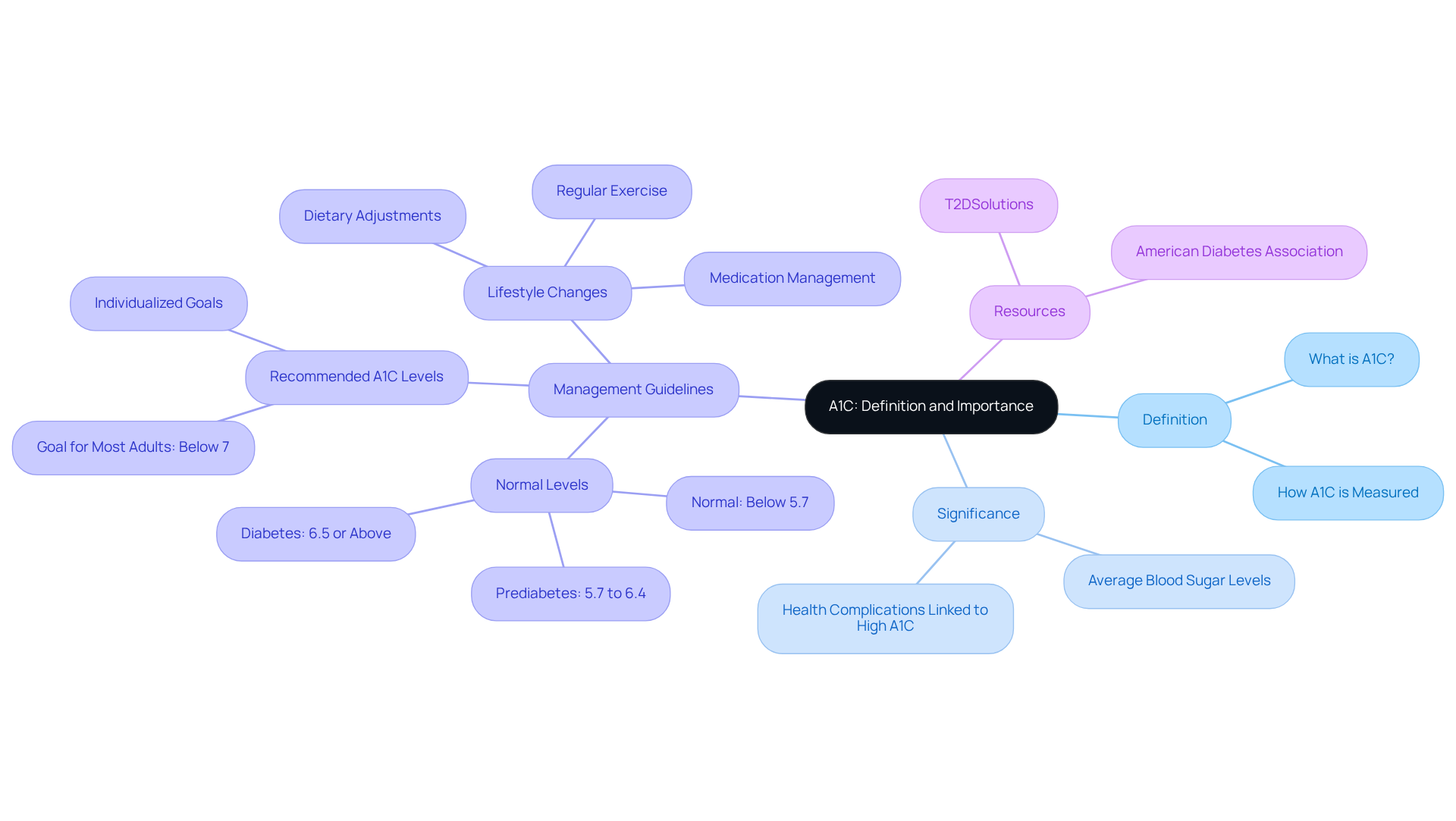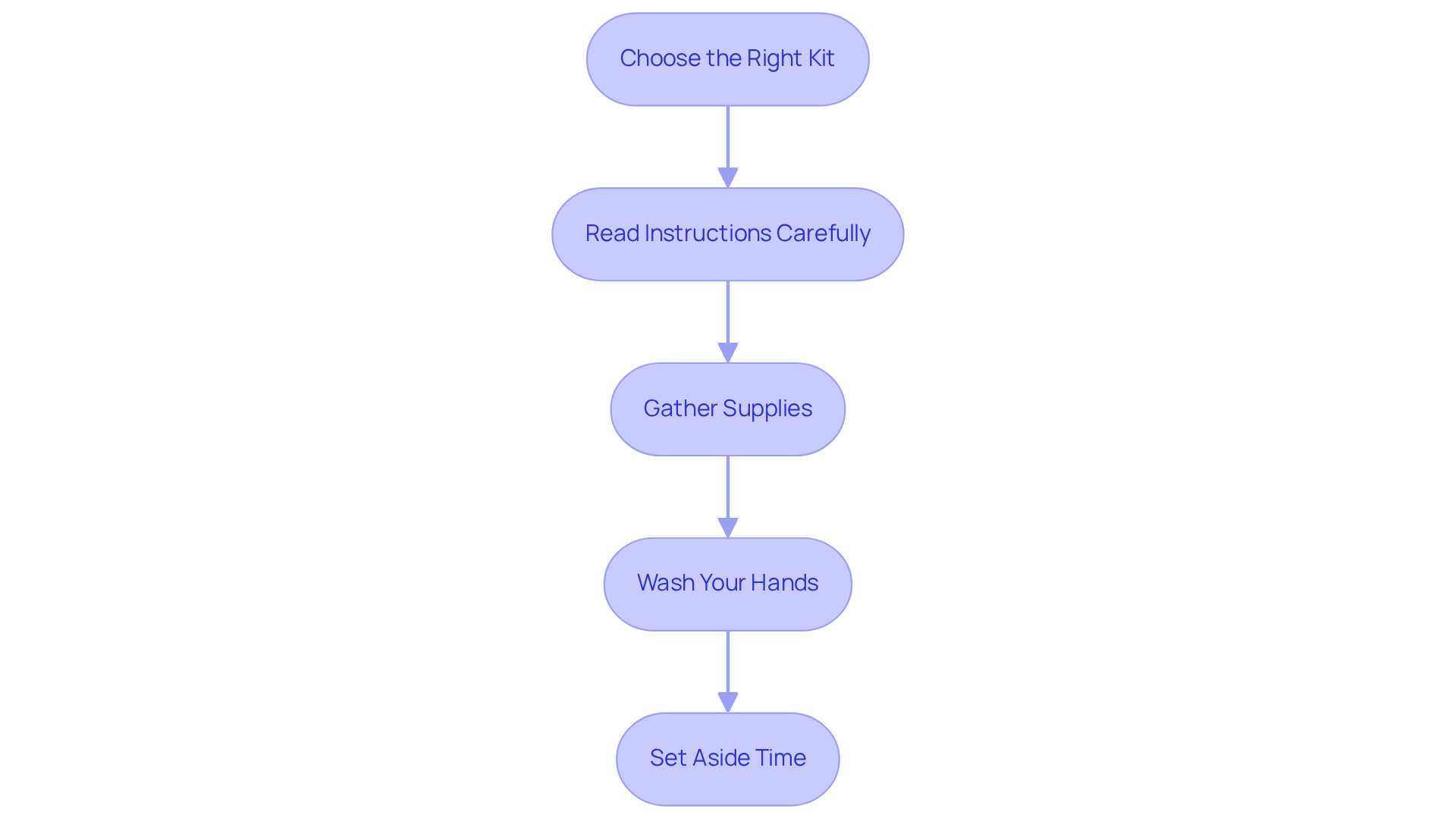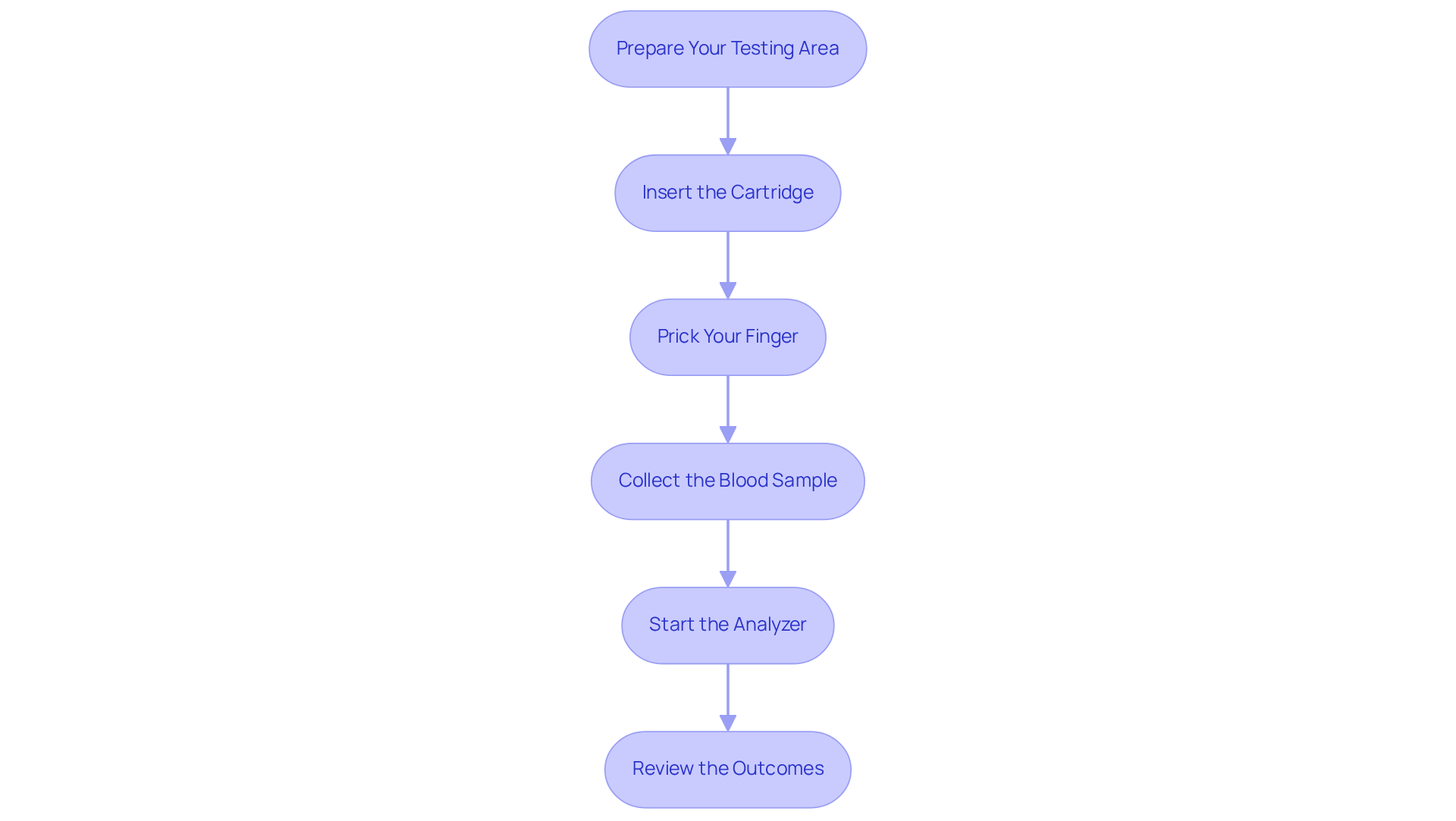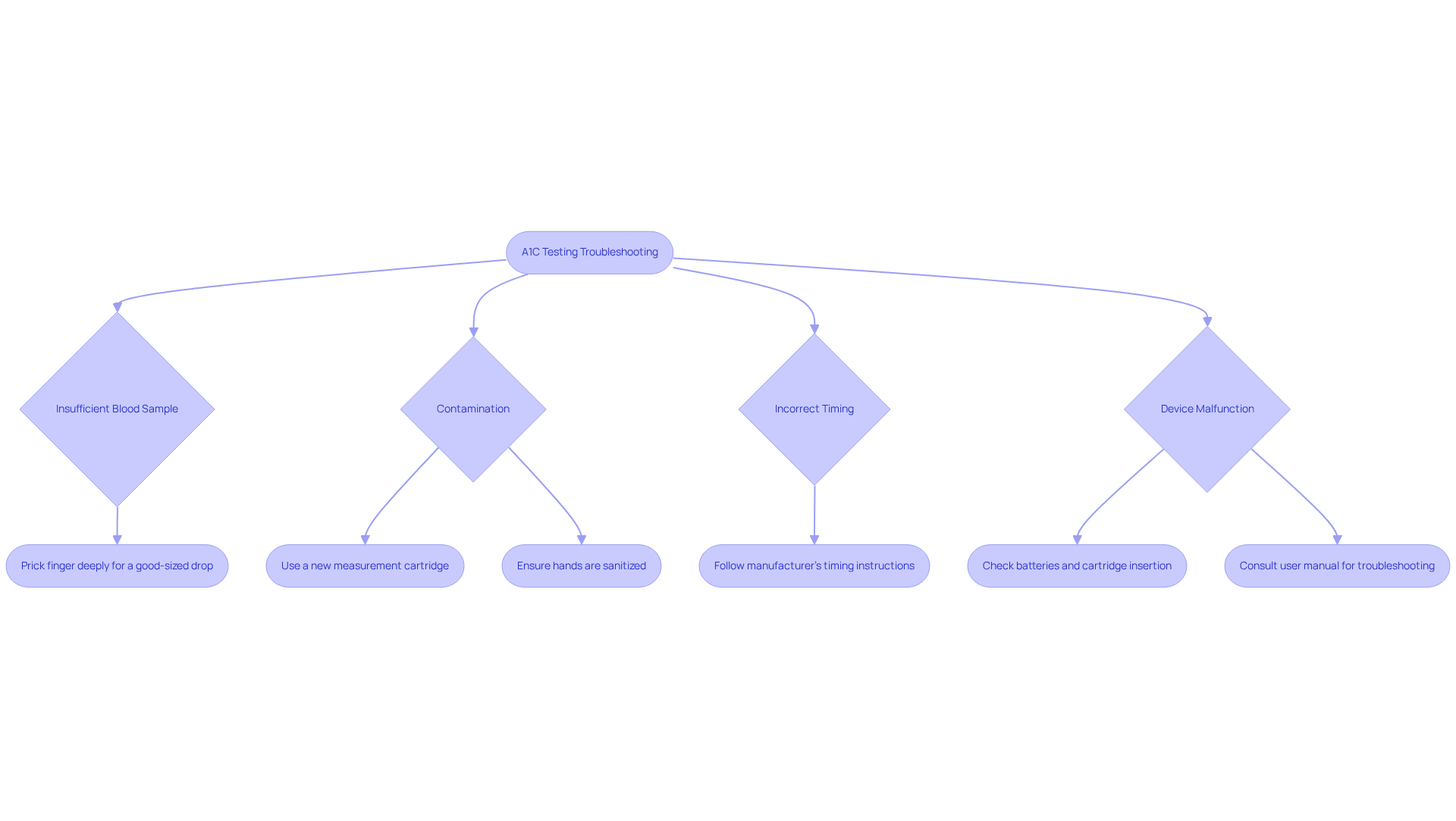Overview
Calculating A1C at home can feel daunting, but with the right approach, you can do it accurately. Start by choosing a reliable testing kit and preparing a clean workspace. It's essential to follow the instructions for blood sample collection and timing carefully. Remember, taking these steps with meticulous attention can lead to reliable results.
These results are crucial for managing your blood sugar levels effectively. They empower you to make informed health decisions, which is so important on your journey. You're not alone in this process; we are here to support you every step of the way. If you have any questions or need assistance, don't hesitate to reach out for help. Together, we can navigate this path toward better health.
Introduction
Understanding the significance of A1C levels is crucial for anyone managing blood sugar issues. It provides a comprehensive view of glucose control over the past few months. This article delves into the essential steps for calculating A1C at home, empowering you to take charge of your health with confidence. However, it’s understandable to wonder what happens when the convenience of at-home testing meets the complexities of accurate measurement.
Exploring the nuances of this process reveals both the potential benefits and common pitfalls. It’s important to grasp the intricacies of A1C testing, as you are not alone in this journey. We are here to support you every step of the way.
Understand A1C: Definition and Importance
A1C, or hemoglobin A1C, is an essential blood test that assesses the average blood sugar levels over the past two to three months. It provides a thorough perspective on glucose management, helping you understand your health better. The results are expressed as a percentage, with higher percentages indicating poorer blood sugar control. For instance, an A1C level below 5.7% is regarded as normal, while levels of 6.5% or above indicate a diagnosis of a blood sugar disorder. Understanding your A1C levels is vital for making informed decisions about treatment and lifestyle adjustments.
Recent studies emphasize the significance of A1C levels in managing blood sugar. Keeping an A1C under 7% is frequently advised for many adults with blood sugar issues to lower the chance of complications. Furthermore, regular A1C testing—typically at least twice a year—enables healthcare providers to adjust management plans effectively, ensuring better health outcomes. It's understandable to feel overwhelmed by all this information, but know that you are not alone in this journey.
Despite its significance, many individuals with blood sugar issues may not fully comprehend the importance of A1C levels. Research indicates that a substantial percentage of individuals with high blood sugar are unaware of how A1C reflects their blood sugar control. This underscores the need for comprehensive education on this topic. T2DSolutions acts as a significant resource for recently diagnosed individuals, offering crucial information and assistance to help them comprehend their A1C levels and manage their condition effectively.
Incorporating insights from case studies, it is evident that individuals who actively monitor their A1C levels and engage in lifestyle changes can achieve significant improvements in their health. Some patients have successfully reduced their A1C to below 6.5% through a combination of dietary adjustments and medication. This showcases the potential for effective management of the condition, and it’s inspiring to see how others have navigated similar challenges.
Ultimately, the A1C assessment serves as a vital tool in understanding blood sugar levels and guiding treatment decisions. By utilizing resources like T2DSolutions, anyone managing diabetes can prioritize regular testing and learn to calculate A1C at home to stay informed about their A1C results. Remember, we are here to support you every step of the way.

Prepare for Your A1C Test: Essential Steps
Preparing for your A1C test can feel daunting, but with the right steps, you can approach it with confidence. Here are some essential guidelines to help you through the process:
-
Choose the Right Kit: It's important to select a trustworthy kit that lets you calculate A1C at home and is FDA-approved. Consider popular options like A1CNow and other certified brands, as they ensure accuracy when you calculate A1C at home.
-
Read Instructions Carefully: Take a moment to thoroughly review the guidelines that come with your assessment kit. Understanding the evaluation process is key to ensuring precise outcomes, and it can help ease any concerns you may have.
-
Gather Supplies: Before you begin, make sure you have all the necessary supplies ready. This includes your examination kit, alcohol wipes, and a timer to keep track of the testing duration. Being prepared can make the process smoother for you.
-
Wash Your Hands: Cleanliness is crucial for obtaining reliable results. Wash your hands with soap and water or use an alcohol wipe to prevent contamination. It’s a simple step that can make a big difference.
-
Set Aside Time: Allocate about 30 minutes for the entire testing process. This will allow you to complete the assessment without interruptions, creating a more relaxed experience.
Remember, you're not alone in this journey. Taking these steps can empower you as you manage your health, and we are here to support you every step of the way.

Calculate A1C at Home: Step-by-Step Instructions
To accurately calculate your A1C at home, it’s important to follow these essential steps with care:
- Prepare Your Testing Area: Choose a clean, flat surface to work on. Lay out all necessary supplies to ensure a smooth process. This preparation can help you feel more at ease.
- Insert the Cartridge: Open your A1C examination kit and carefully place the cartridge into the analyzer, following the provided instructions closely.
- Prick Your Finger: Use the included lancet to gently prick the side of your fingertip. It’s understandable to feel a bit anxious, but obtaining a sufficient blood sample is crucial.
- Collect the Blood Sample: Place the blood drop onto the test cartridge as directed. Make sure there is enough blood for an accurate reading; your health matters.
- Start the Analyzer: Close the analyzer and start the timer as instructed. Wait patiently for the designated processing time to ensure precise outcomes.
- Review the Outcomes: Once the timer goes off, check the outcomes displayed on the analyzer. Record your A1C percentage for future reference; this information is valuable for your health journey.
Common errors in at-home A1C testing include not using enough blood, improper handling of the test kit, and failing to follow the timing instructions. These errors can lead to flawed outcomes, which is why it’s vital to follow the guidelines closely.
According to Jewels Doskicz, RN, BA, "Home A1C testing is a useful tool, but it’s not helpful if you don’t take action on the results." Many users have shared their success stories, emphasizing that with meticulous attention to detail, they have effectively learned how to calculate A1C at home, leading to improved management of their condition. Statistics show that the target A1C level for most adults with diabetes is generally less than 7%, underscoring the importance of regular monitoring.
Healthcare specialists highlight that while home assessments can be convenient, it is crucial to verify findings with laboratory examinations for precision. Don’t hesitate to address any worries with your healthcare provider; remember, you’re not alone in this journey. We are here to support you every step of the way.

Troubleshoot Common A1C Testing Issues
When you calculate A1C at home, it's common to encounter some challenges. Here are essential troubleshooting tips to help you achieve accurate results:
-
Insufficient Blood Sample: It’s understandable to feel frustrated if your results are invalid due to an insufficient blood sample. To avoid this, make sure to prick your finger deeply enough to produce a good-sized drop of blood. Insufficient samples can lead to inaccurate readings, so aim for a steady flow. Remember, as stated by the American Diabetes Association, outcomes can vary by as much as 0.5% among different laboratories for the HbA1c assessment, highlighting the importance of obtaining an adequate sample.
-
Contamination: If you suspect contamination, don’t hesitate to repeat the examination. Use a new measurement cartridge and ensure your hands are completely sanitized before testing. This step is crucial to prevent any external substances from affecting your results.
-
Incorrect Timing: Adhering to the timing instructions is vital. If you wait too long or not long enough before reading the results, it can significantly impact accuracy. Always follow the manufacturer’s guidelines closely. The ADA recommends checking HbA1c twice a year for stable patients, reinforcing the need for precise testing.
-
Device Malfunction: If your analyzer fails to turn on or shows an error message, start by checking the batteries. Ensure the test cartridge is inserted correctly and consult the user manual for specific troubleshooting steps. Regular maintenance of your device can prevent many common issues.
By addressing these possible issues proactively, you can enhance the reliability of how you calculate A1C at home, which is a crucial step in managing your blood sugar levels effectively. Remember, you’re not alone in this journey. As diabetes specialists emphasize, "Understanding the nuances of A1C testing is crucial for effective diabetes management." We are here to support you every step of the way.

Conclusion
Understanding A1C levels is a vital aspect of effectively managing blood sugar, and calculating A1C at home empowers you to take control of your health. By familiarizing yourself with the testing process—preparation, execution, and troubleshooting—you can navigate the complexities of at-home testing with confidence.
Key insights throughout this article highlight the importance of A1C as a reflection of long-term glucose management. Regular monitoring, utilizing reliable testing kits, and being aware of common testing pitfalls can significantly enhance the accuracy of your results. Moreover, support from resources like T2DSolutions can provide essential guidance, ensuring you are well-informed and capable of making necessary lifestyle adjustments.
Ultimately, the journey of managing blood sugar is a shared experience. Taking proactive steps to understand and monitor A1C levels can lead to improved health outcomes and greater peace of mind. Engaging with healthcare providers and utilizing available resources can further bolster this effort, reinforcing the message that informed individuals are empowered individuals.
Remember, you're not alone in this journey. Embrace the process, stay informed, and take charge of your health with confidence. We are here to support you every step of the way.
Frequently Asked Questions
What is A1C and why is it important?
A1C, or hemoglobin A1C, is a blood test that measures the average blood sugar levels over the past two to three months. It is important because it provides insights into glucose management and helps individuals understand their health better.
How are A1C results expressed and what do they indicate?
A1C results are expressed as a percentage. Higher percentages indicate poorer blood sugar control. An A1C level below 5.7% is considered normal, while levels of 6.5% or above indicate a diagnosis of a blood sugar disorder.
What is the recommended A1C level for adults with blood sugar issues?
It is frequently advised that many adults with blood sugar issues keep their A1C under 7% to lower the risk of complications.
How often should A1C testing be done?
Regular A1C testing is typically recommended at least twice a year to allow healthcare providers to adjust management plans effectively.
Why do many individuals with blood sugar issues lack understanding of A1C?
Research indicates that a substantial percentage of individuals with high blood sugar are unaware of how A1C reflects their blood sugar control, highlighting the need for comprehensive education on this topic.
How can individuals manage their A1C levels effectively?
Individuals who actively monitor their A1C levels and engage in lifestyle changes, such as dietary adjustments and medication, can achieve significant improvements in their health, including reducing their A1C to below 6.5%.
What resources are available for understanding and managing A1C levels?
T2DSolutions is a significant resource for recently diagnosed individuals, offering crucial information and assistance to help them comprehend their A1C levels and manage their condition effectively.
Can A1C be calculated at home?
Yes, individuals can learn to calculate their A1C at home to stay informed about their results, which is encouraged as part of managing diabetes.



